BC Lakes Stewardship Monitoring Program Annual Data Review
TABOR LAKE
This report summarizes information collected from TABOR LAKE (Station ID: 0400336), which is part of a group of lakes sampled at a provincial scale under the B.C. Lake Stewardship Monitoring Program (BCLSMP). BCLSMP is operated by the B.C. Ministry of Environment and Parks (ENV) in partnership with the B.C. Lake Stewardship Society (BCLSS; www.bclss.org). For more information on BCLSMP including methods, data and reports visit the program website at www.gov.bc.ca/lakestewardshipmonitoring.
The Level 3 program for TABOR LAKE has been ongoing since 1994. BCLSMP data were collected by volunteer citizen scientists, with a target of 12 sampling dates per year during the open water season, and includes Secchi depths (i.e., water clarity), temperature and dissolved oxygen profiles. During each sampling visit water samples were also collected at three depths: shallow (1 m below surface), mid column, and deep (1 m above lake bottom). Water samples were analyzed for chlorophyll-a (an indicator of algal biomass) and phosphorus parameters: total phosphorus, total dissolved phosphorus, and ortho-phosphorus. This data provides information on the water quality conditions of the lake throughout the ice-free season and help us understand important lake characteristics including summer oxygen depletion and productivity. Level 3 monitoring programs are conducted over a three-year period to account for inter-annual variability of conditions which can affect water quality such as climate.
Monitoring Results
The sample results presented below are grouped into four categories: Temperature and dissolved oxygen, water clarity and algal productivity, nutrient concentration, and trophic status.
The field and water chemistry data used for this review has been added to a government server for public access available through these links:
Water Chemistry data is here. Profile data is here. Secchi data is here.
1994-2019
Lake Profiles
Most interior B.C. lakes stratify and form distinct layers as the air temperature warms them. The coldest water is near the bottom of a lake, and since colder water is denser it resists mixing into the warmer, upper layer for much of the summer. In early-spring and fall, these lakes typically mix from top to bottom (a process called overturn) as wind energy overcomes the temperature and density differences between surface and bottom waters. Temperature and dissolved oxygen strongly influence physical, chemical and biological processes in lakes.
Temperature (°C) and dissolved oxygen (mg/L) readings are recorded at 1 m intervals through the lake water column during each volunteer sampling event. The results of these profiles are displayed below in contour plots. The colours in the plots represent temperature and dissolved oxygen gradients. The temperature and oxygen value that matches each colour is shown on the chart along the right side. These plots assist in understanding seasonal lake stratification patterns.
Lake profiles for Tabor Lake were not collected until 2021. Below are temperature and dissolved oxygen plots from data taken at each of the three sampling depths.
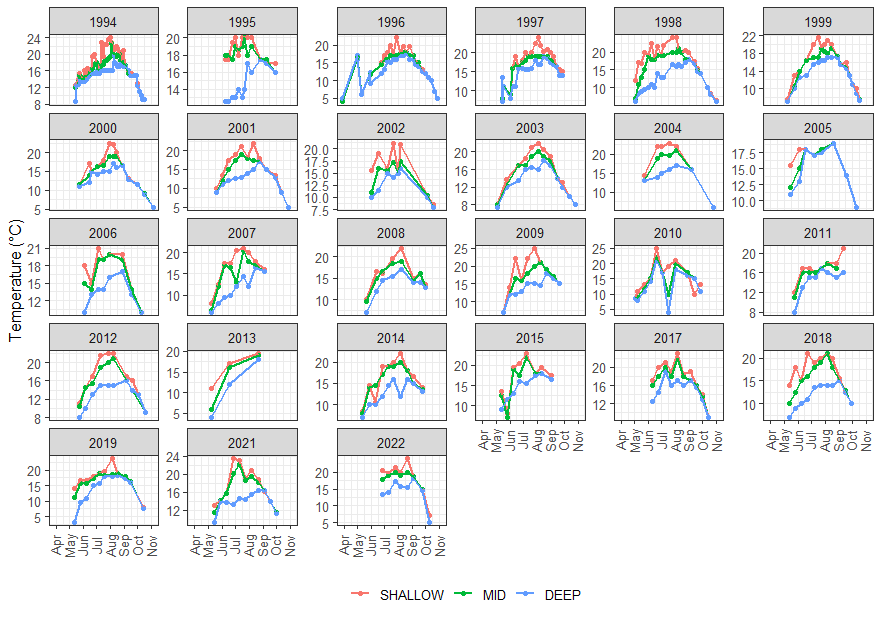
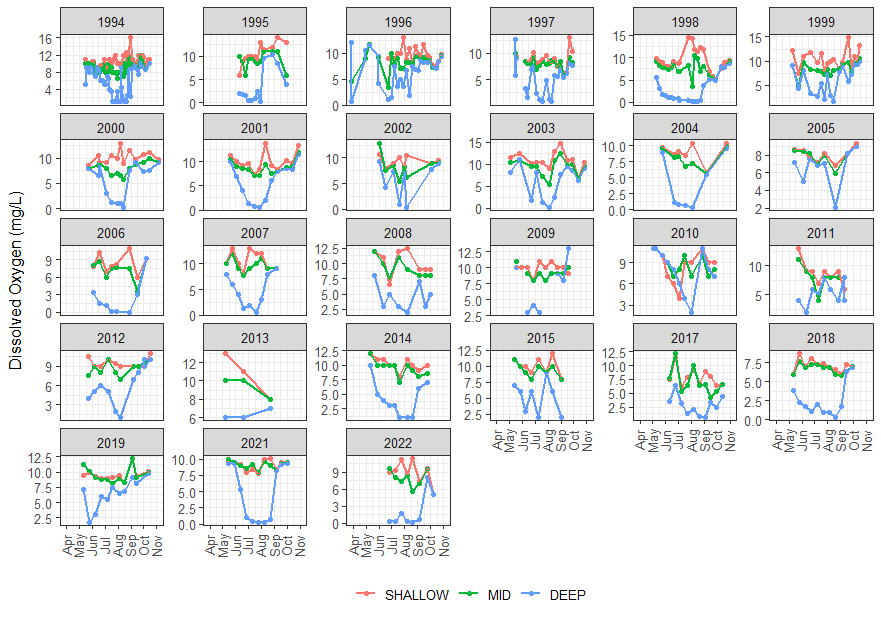
Water Clarity and Algal Productivity
Water clarity is measured using a Secchi disk. The Secchi depth can be used as an indicator of the presence of algal cells or other particulates, such as pollen, in the water column. For example, a deeper Secchi depth suggests clear water while a shallow Secchi depth suggests “cloudy” water which may be caused by the presence of algae. The following figure shows the Secchi depths collected by volunteer samplers at each sampling event.
The concentration of chlorophyll a in lakes is an indicator of algal productivity. Chlorophyll-a is a common pigment found in almost all plants and is used by plant life to capture the light energy that drives photosynthesis. In lakes chlorophyll-a occurs in photosynthetic organisms ranging from free-floating microscopic algae in the water column (phytoplankton) to rooted aquatic plants (macrophytes).
The following figure shows chlorophyll-a concentrations and the corresponding Secchi depths collected by volunteer samplers at each sampling event.
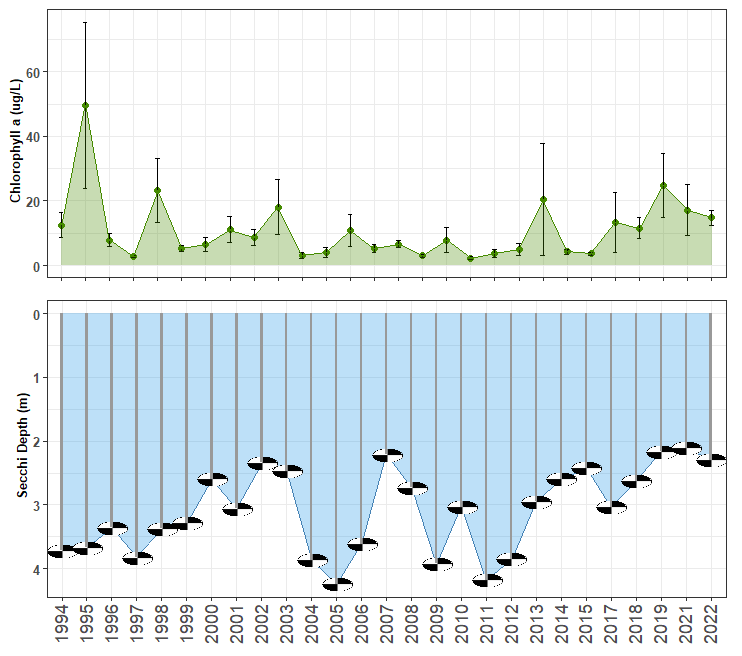
Nutrient Concentrations
Nitrogen and phosphorus are two of the most important nutrients to lake productivity. Most lakes in B.C. are phosphorus limited, meaning that phosphorus is the nutrient in shortest supply and thus acts to limit the production of aquatic plants and algae. When in excess, phosphorus accelerates growth and may artificially age a lake. Phosphorus exists in both total and dissolved forms. The dissolved form ortho-phosphate is the most bioavailable (easily used) by aquatic plants and algae for growth. Total phosphorus and total dissolved phosphorus are important for understanding how much potentially available phosphorus is in the lake. Examining all three forms provides more detail on the phosphorus loading dynamics of the lake. Level 3 monitoring programs sample water to analyze for total phosphorus, total dissolved phosphorus and ortho-phosphate. The graph below shows the concentrations of each of these during each volunteer sampling event.
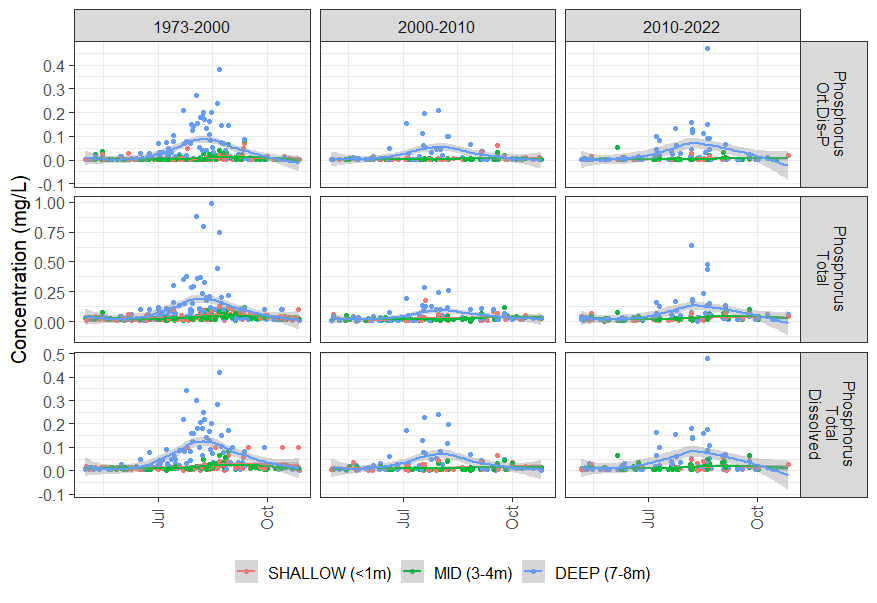
2021
Lake Profiles
Most interior B.C. lakes stratify and form distinct layers as the air temperature warms them. The coldest water is near the bottom of a lake, and since colder water is denser it resists mixing into the warmer, upper layer for much of the summer. In early-spring and fall, these lakes typically mix from top to bottom (a process called overturn) as wind energy overcomes the temperature and density differences between surface and bottom waters. Temperature and dissolved oxygen strongly influence physical, chemical and biological processes in lakes.
Temperature (°C) and dissolved oxygen (mg/L) readings are recorded at 1 m intervals through the lake water column during each volunteer sampling event. The results of these profiles are displayed below in contour plots. Mathematical estimation, or interpolation, is used to create a plot that is easier to visualize the temperature and oxygen patterns at the sample location. This means that all the data shown in the plots between the collected sample points, both the depths and dates, are mathematically estimated from the known values before and after it. The colours in the plots represent temperature and dissolved oxygen gradients. The temperature and oxygen value that matches each colour is shown on the chart along the right side. These plots assist in understanding seasonal lake stratification patterns.
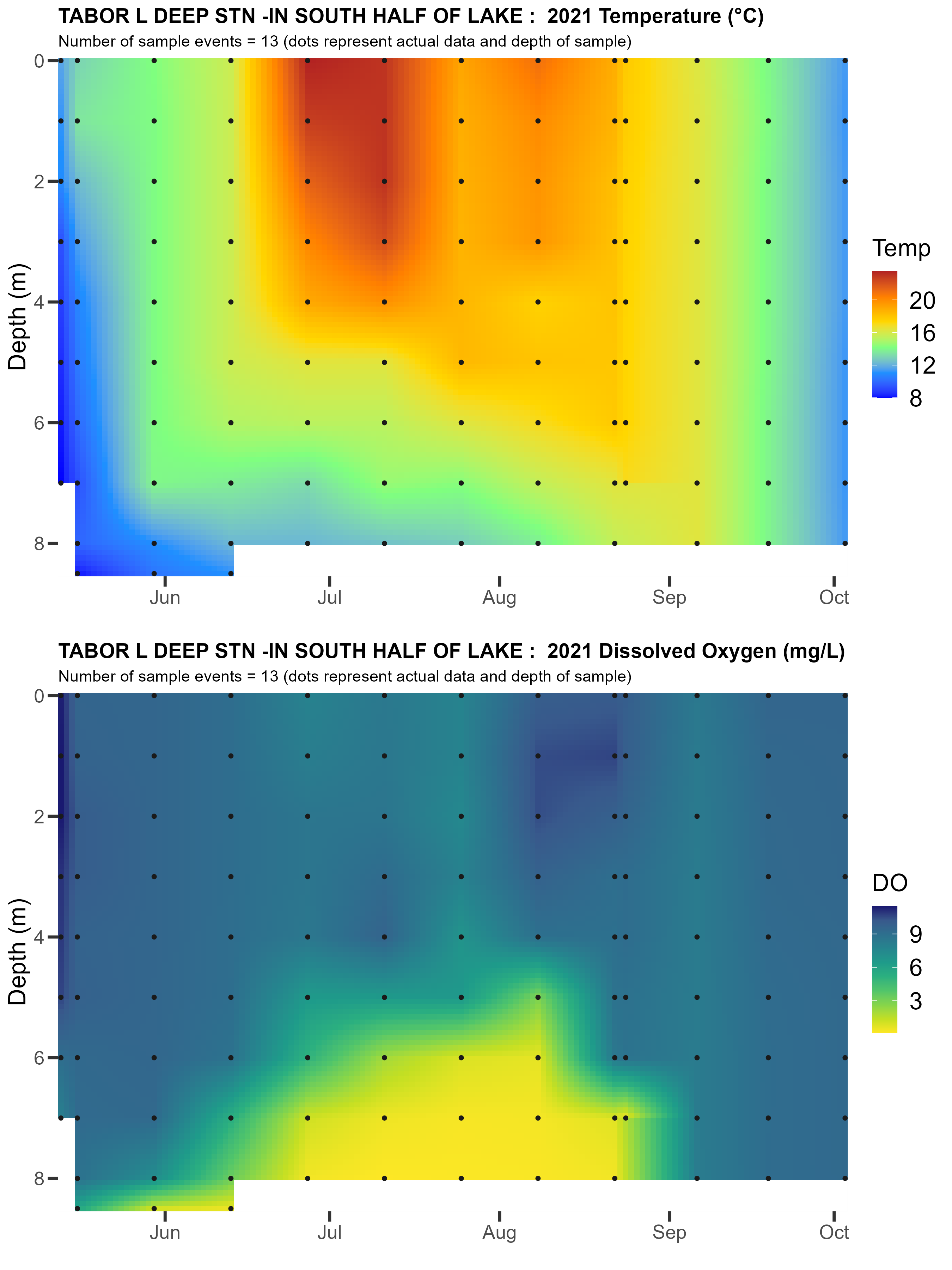
Water Clarity and Algal Productivity
Water clarity is measured using a Secchi disk. The Secchi depth can be used as an indicator of the presence of algal cells or other particulates, such as pollen, in the water column. For example, a deeper Secchi depth suggests clear water while a shallow Secchi depth suggests “cloudy” water which may be caused by the presence of algae. The following figure shows the Secchi depths collected by volunteer samplers at each sampling event.
The concentration of chlorophyll a in lakes is an indicator of algal productivity. Chlorophyll-a is a common pigment found in almost all plants and is used by plant life to capture the light energy that drives photosynthesis. In lakes chlorophyll-a occurs in photosynthetic organisms ranging from free-floating microscopic algae in the water column (phytoplankton) to rooted aquatic plants (macrophytes).
The following figure shows chlorophyll-a concentrations and the corresponding Secchi depths collected by volunteer samplers at each sampling event.
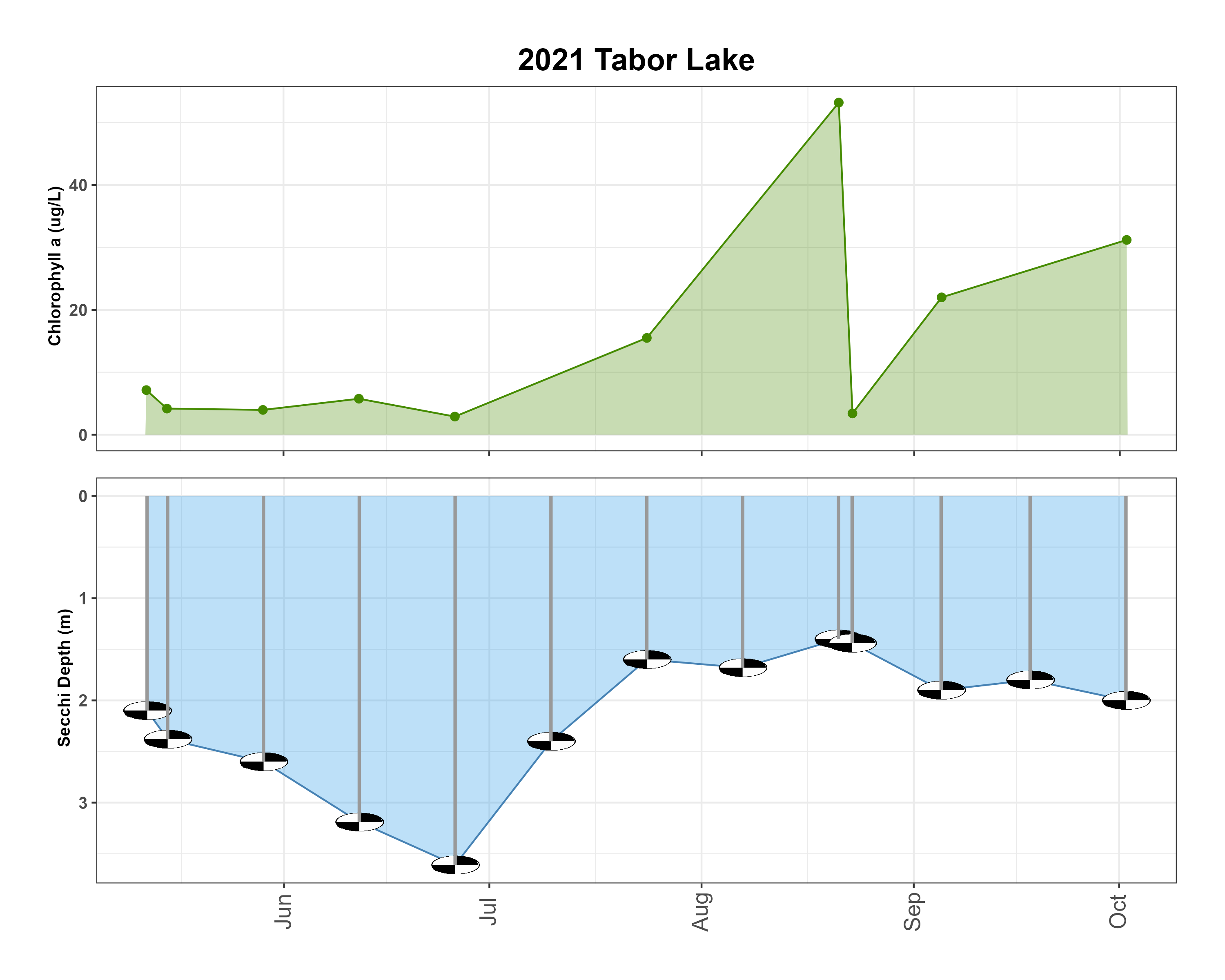
Nutrient Concentrations
Nitrogen and phosphorus are two of the most important nutrients to lake productivity. Most lakes in B.C. are phosphorus limited, meaning that phosphorus is the nutrient in shortest supply and thus acts to limit the production of aquatic plants and algae. When in excess, phosphorus accelerates growth and may artificially age a lake. Phosphorus exists in both total and dissolved forms. The dissolved form ortho-phosphate is the most bioavailable (easily used) by aquatic plants and algae for growth. Total phosphorus and total dissolved phosphorus are important for understanding how much potentially available phosphorus is in the lake. Examining all three forms provides more detail on the phosphorus loading dynamics of the lake. Level 3 monitoring programs sample water to analyze for total phosphorus, total dissolved phosphorus and ortho-phosphate. The graph below shows the concentrations of each of these during each volunteer sampling event.
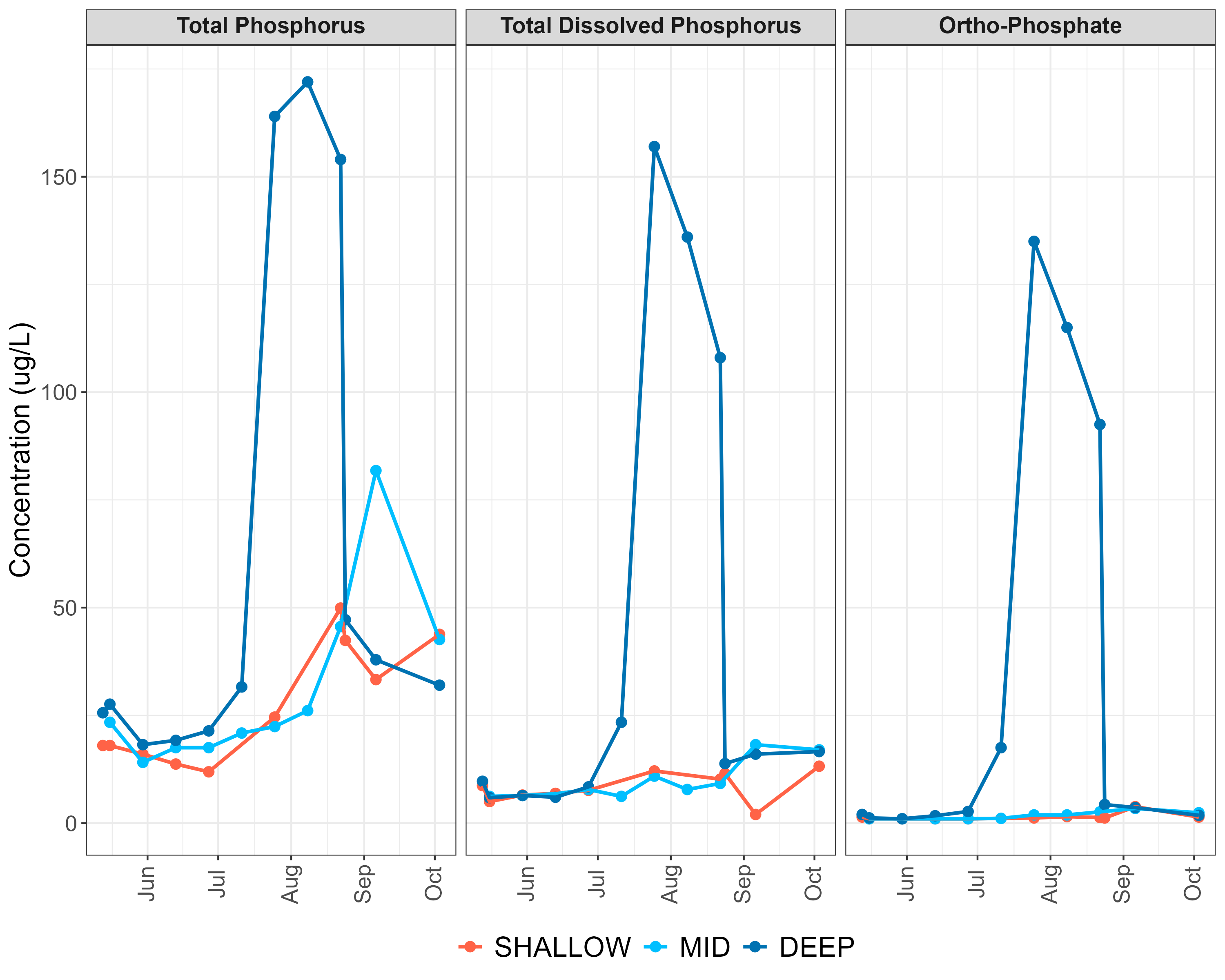
Lake Results Summary Table
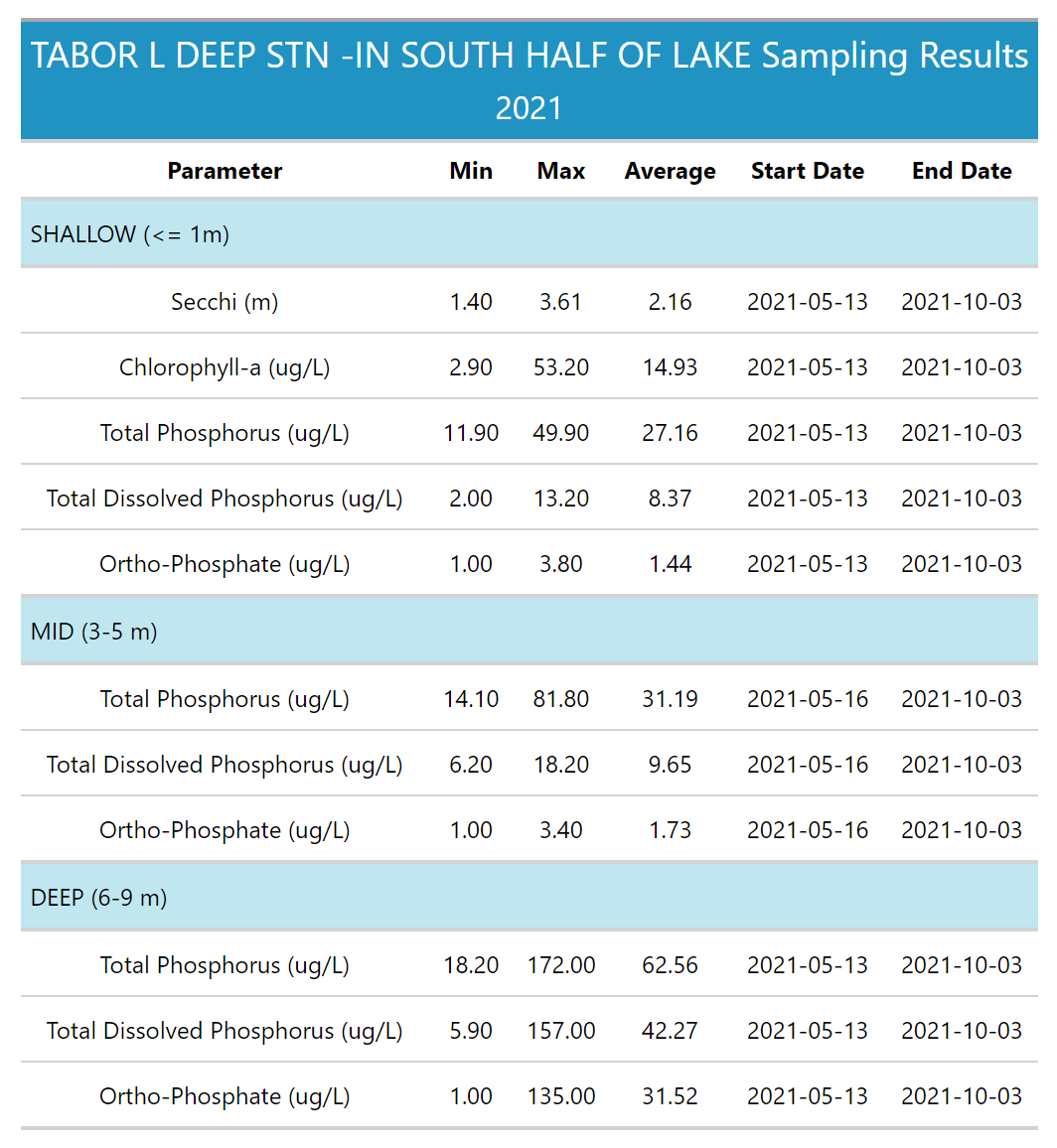
2022
Lake Profiles
Most interior B.C. lakes stratify and form distinct layers as the air temperature warms them. The coldest water is near the bottom of a lake, and since colder water is denser it resists mixing into the warmer, upper layer for much of the summer. In early-spring and fall, these lakes typically mix from top to bottom (a process called overturn) as wind energy overcomes the temperature and density differences between surface and bottom waters. Temperature and dissolved oxygen strongly influence physical, chemical and biological processes in lakes.
Temperature (°C) and dissolved oxygen (mg/L) readings are recorded at 1 m intervals through the lake water column during each volunteer sampling event. The results of these profiles are displayed below in contour plots. Mathematical estimation, or interpolation, is used to create a plot that is easier to visualize the temperature and oxygen patterns at the sample location. This means that all the data shown in the plots between the collected sample points, both the depths and dates, are mathematically estimated from the known values before and after it. The colours in the plots represent temperature and dissolved oxygen gradients. The temperature and oxygen value that matches each colour is shown on the chart along the right side. These plots assist in understanding seasonal lake stratification patterns.
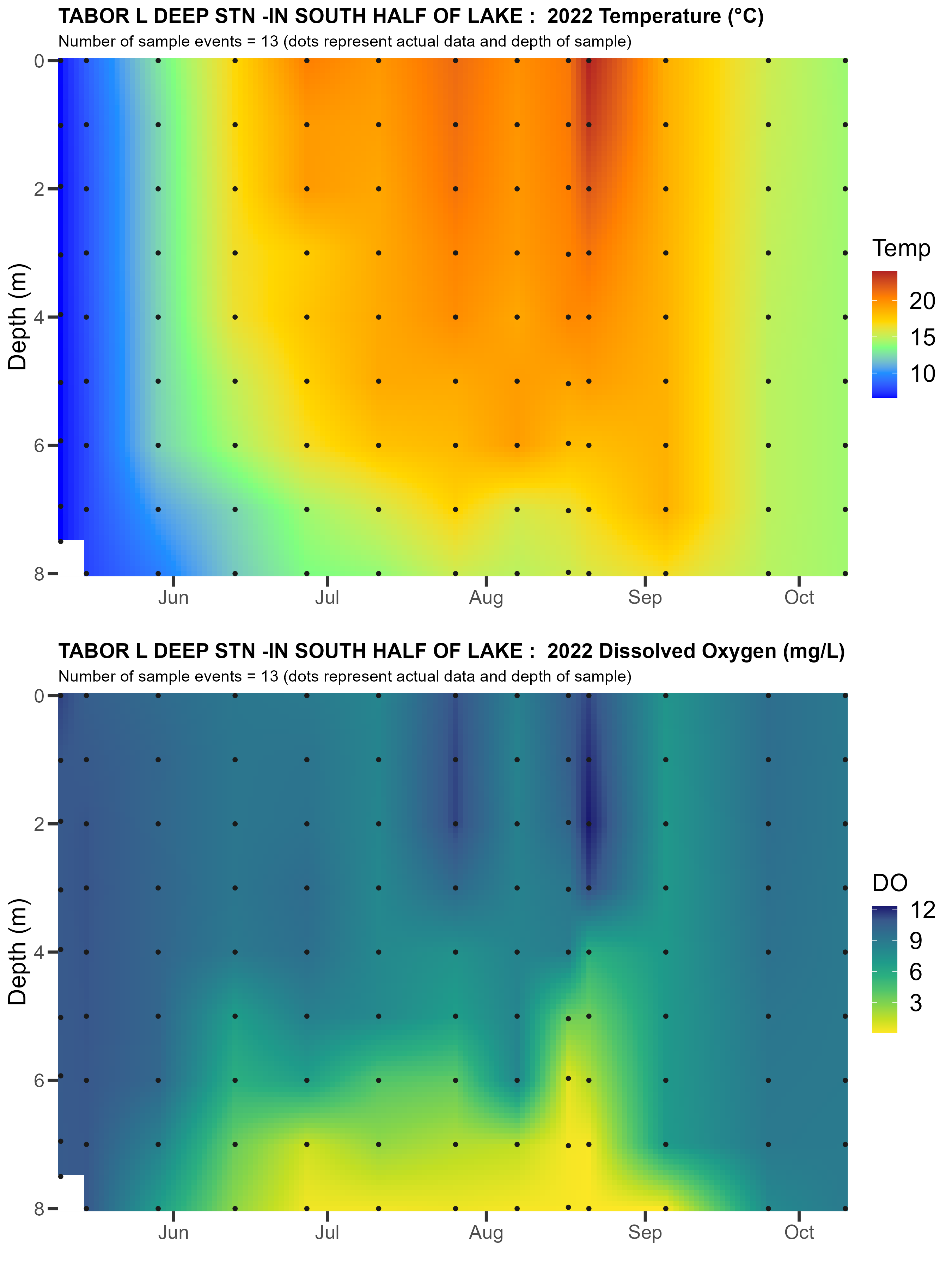
Water Clarity and Algal Productivity
Water clarity is measured using a Secchi disk. The Secchi depth can be used as an indicator of the presence of algal cells or other particulates, such as pollen, in the water column. For example, a deeper Secchi depth suggests clear water while a shallow Secchi depth suggests “cloudy” water which may be caused by the presence of algae. The following figure shows the Secchi depths collected by volunteer samplers at each sampling event.
The concentration of chlorophyll a in lakes is an indicator of algal productivity. Chlorophyll-a is a common pigment found in almost all plants and is used by plant life to capture the light energy that drives photosynthesis. In lakes chlorophyll-a occurs in photosynthetic organisms ranging from free-floating microscopic algae in the water column (phytoplankton) to rooted aquatic plants (macrophytes).
The following figure shows chlorophyll-a concentrations and the corresponding Secchi depths collected by volunteer samplers at each sampling event.

Nutrient Concentrations
Nitrogen and phosphorus are two of the most important nutrients to lake productivity. Most lakes in B.C. are phosphorus limited, meaning that phosphorus is the nutrient in shortest supply and thus acts to limit the production of aquatic plants and algae. When in excess, phosphorus accelerates growth and may artificially age a lake. Phosphorus exists in both total and dissolved forms. The dissolved form ortho-phosphate is the most bioavailable (easily used) by aquatic plants and algae for growth. Total phosphorus and total dissolved phosphorus are important for understanding how much potentially available phosphorus is in the lake. Examining all three forms provides more detail on the phosphorus loading dynamics of the lake. Level 3 monitoring programs sample water to analyze for total phosphorus, total dissolved phosphorus and ortho-phosphate. The graph below shows the concentrations of each of these during each volunteer sampling event.
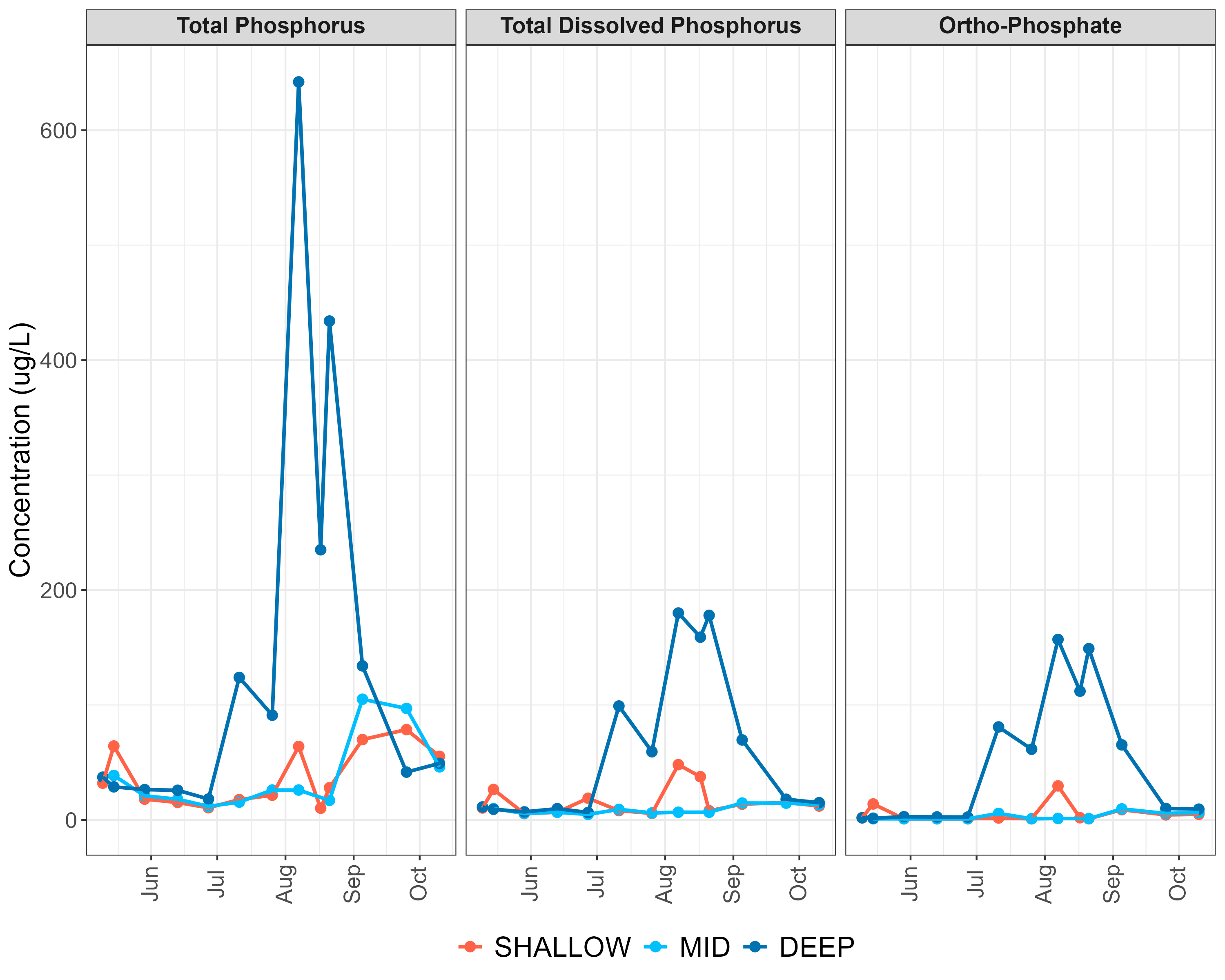
Lake Results Summary Table
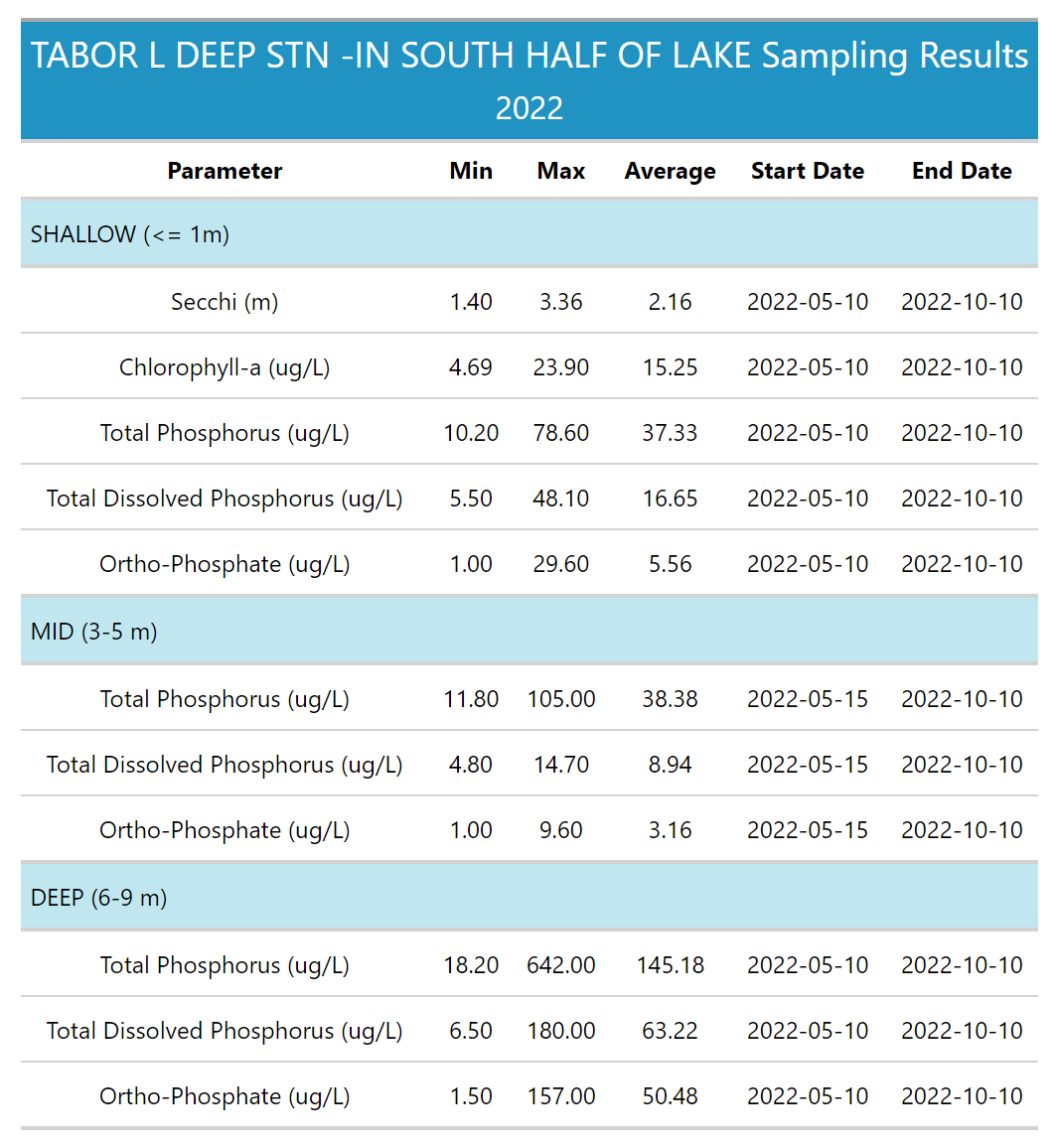
2023
Lake Profiles
Most interior B.C. lakes stratify and form distinct layers as the air temperature warms them. The coldest water is near the bottom of a lake, and since colder water is denser it resists mixing into the warmer, upper layer for much of the summer. In early-spring and fall, these lakes typically mix from top to bottom (a process called overturn) as wind energy overcomes the temperature and density differences between surface and bottom waters. Temperature and dissolved oxygen strongly influence physical, chemical and biological processes in lakes.
Temperature (°C) and dissolved oxygen (mg/L) readings are recorded at 1 m intervals through the lake water column during each volunteer sampling event. The results of these profiles are displayed below in contour plots. Mathematical estimation, or interpolation, is used to create a plot that is easier to visualize the temperature and oxygen patterns at the sample location. This means that all the data shown in the plots between the collected sample points, both the depths and dates, are mathematically estimated from the known values before and after it. The colours in the plots represent temperature and dissolved oxygen gradients. The temperature and oxygen value that matches each colour is shown on the chart along the right side. These plots assist in understanding seasonal lake stratification patterns.
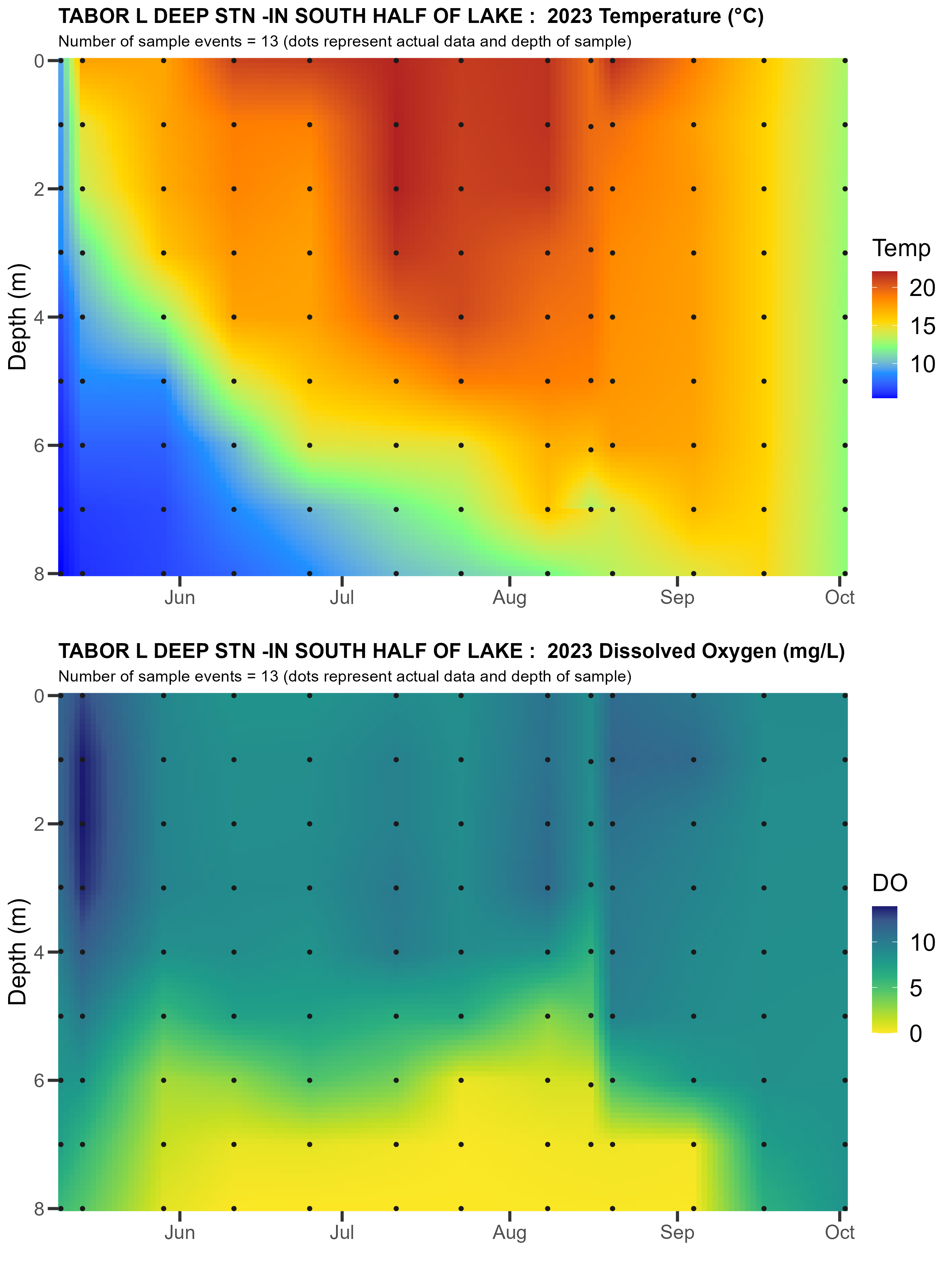
Water Clarity and Algal Productivity
Water clarity is measured using a Secchi disk. The Secchi depth can be used as an indicator of the presence of algal cells or other particulates, such as pollen, in the water column. For example, a deeper Secchi depth suggests clear water while a shallow Secchi depth suggests “cloudy” water which may be caused by the presence of algae. The following figure shows the Secchi depths collected by volunteer samplers at each sampling event.
The concentration of chlorophyll a in lakes is an indicator of algal productivity. Chlorophyll-a is a common pigment found in almost all plants and is used by plant life to capture the light energy that drives photosynthesis. In lakes chlorophyll-a occurs in photosynthetic organisms ranging from free-floating microscopic algae in the water column (phytoplankton) to rooted aquatic plants (macrophytes).
The following figure shows chlorophyll-a concentrations and the corresponding Secchi depths collected by volunteer samplers at each sampling event.
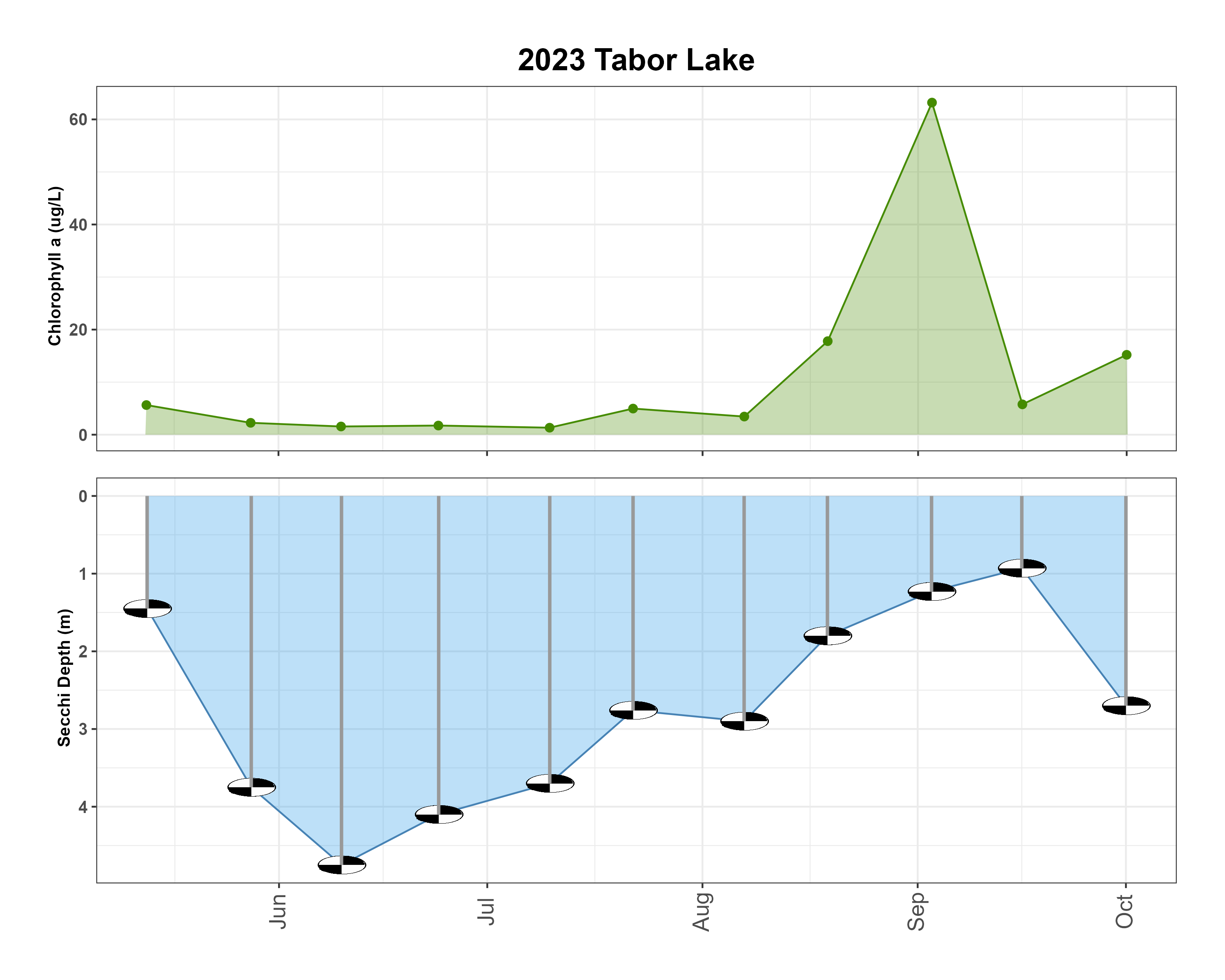
Nutrient Concentrations
Nitrogen and phosphorus are two of the most important nutrients to lake productivity. Most lakes in B.C. are phosphorus limited, meaning that phosphorus is the nutrient in shortest supply and thus acts to limit the production of aquatic plants and algae. When in excess, phosphorus accelerates growth and may artificially age a lake. Phosphorus exists in both total and dissolved forms. The dissolved form ortho-phosphate is the most bioavailable (easily used) by aquatic plants and algae for growth. Total phosphorus and total dissolved phosphorus are important for understanding how much potentially available phosphorus is in the lake. Examining all three forms provides more detail on the phosphorus loading dynamics of the lake. Level 3 monitoring programs sample water to analyze for total phosphorus, total dissolved phosphorus and ortho-phosphate. The graph below shows the concentrations of each of these during each volunteer sampling event.
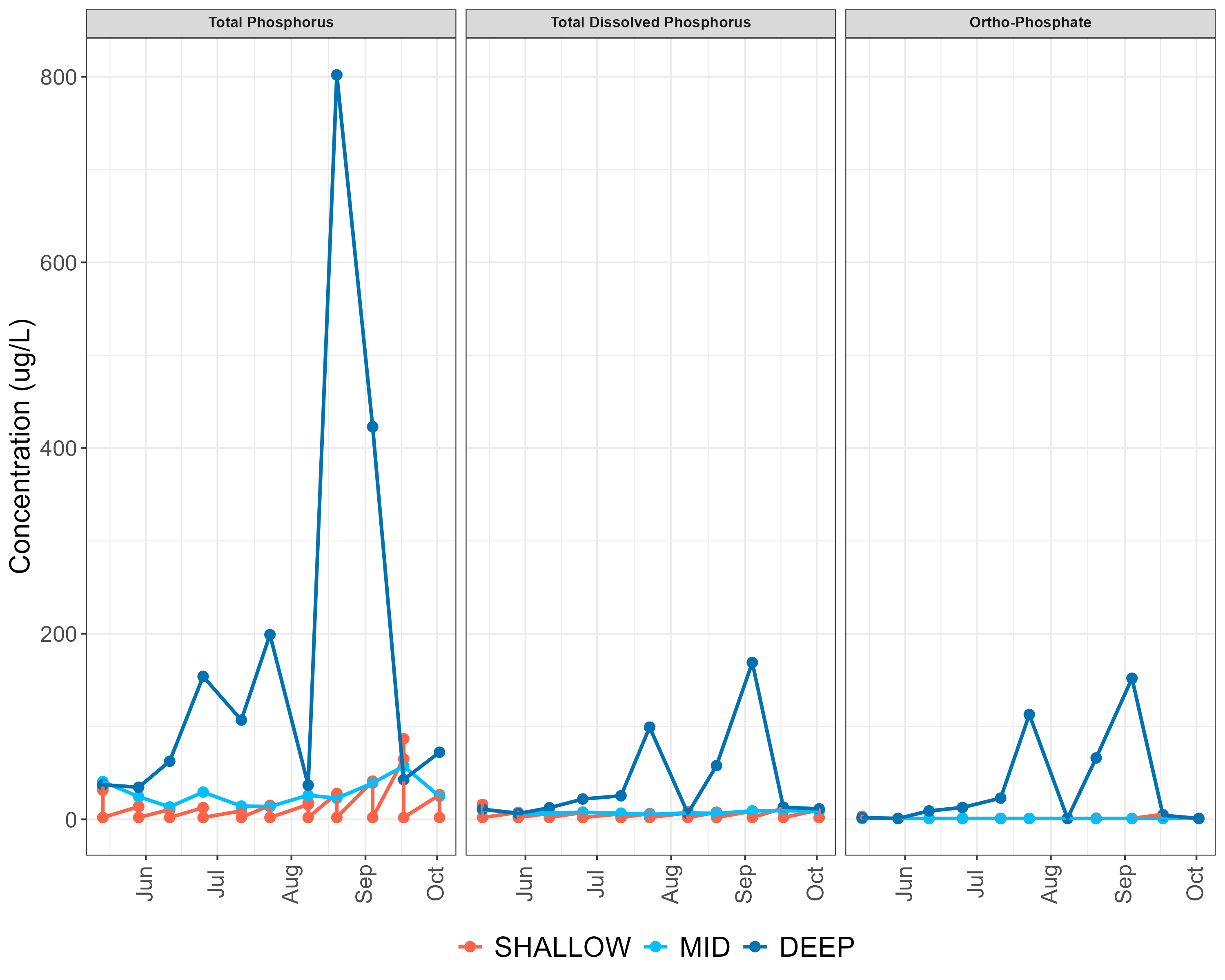
Lake Results Summary Table
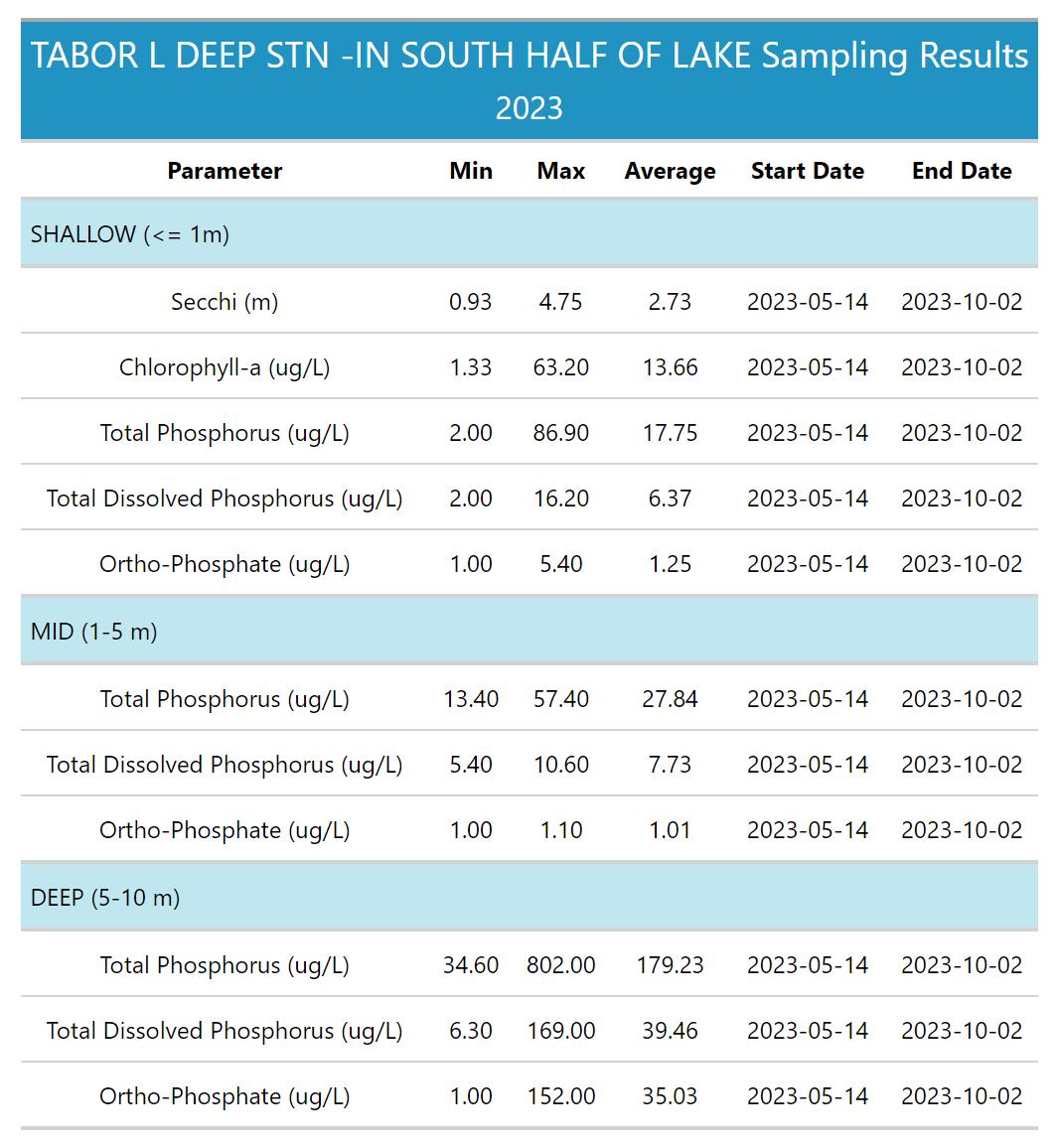
2024
Lake Profiles
Most interior B.C. lakes stratify and form distinct layers as the air temperature warms them. The coldest water is near the bottom of a lake, and since colder water is denser it resists mixing into the warmer, upper layer for much of the summer. In early-spring and fall, these lakes typically mix from top to bottom (a process called overturn) as wind energy overcomes the temperature and density differences between surface and bottom waters. Temperature and dissolved oxygen strongly influence physical, chemical and biological processes in lakes.
Temperature (°C) and dissolved oxygen (mg/L) readings are recorded at 1 m intervals through the lake water column during each volunteer sampling event. The results of these profiles are displayed below in contour plots. Mathematical estimation, or interpolation, is used to create a plot that is easier to visualize the temperature and oxygen patterns at the sample location. This means that all the data shown in the plots between the collected sample points, both the depths and dates, are mathematically estimated from the known values before and after it. The colours in the plots represent temperature and dissolved oxygen gradients. The temperature and oxygen value that matches each colour is shown on the chart along the right side. These plots assist in understanding seasonal lake stratification patterns.
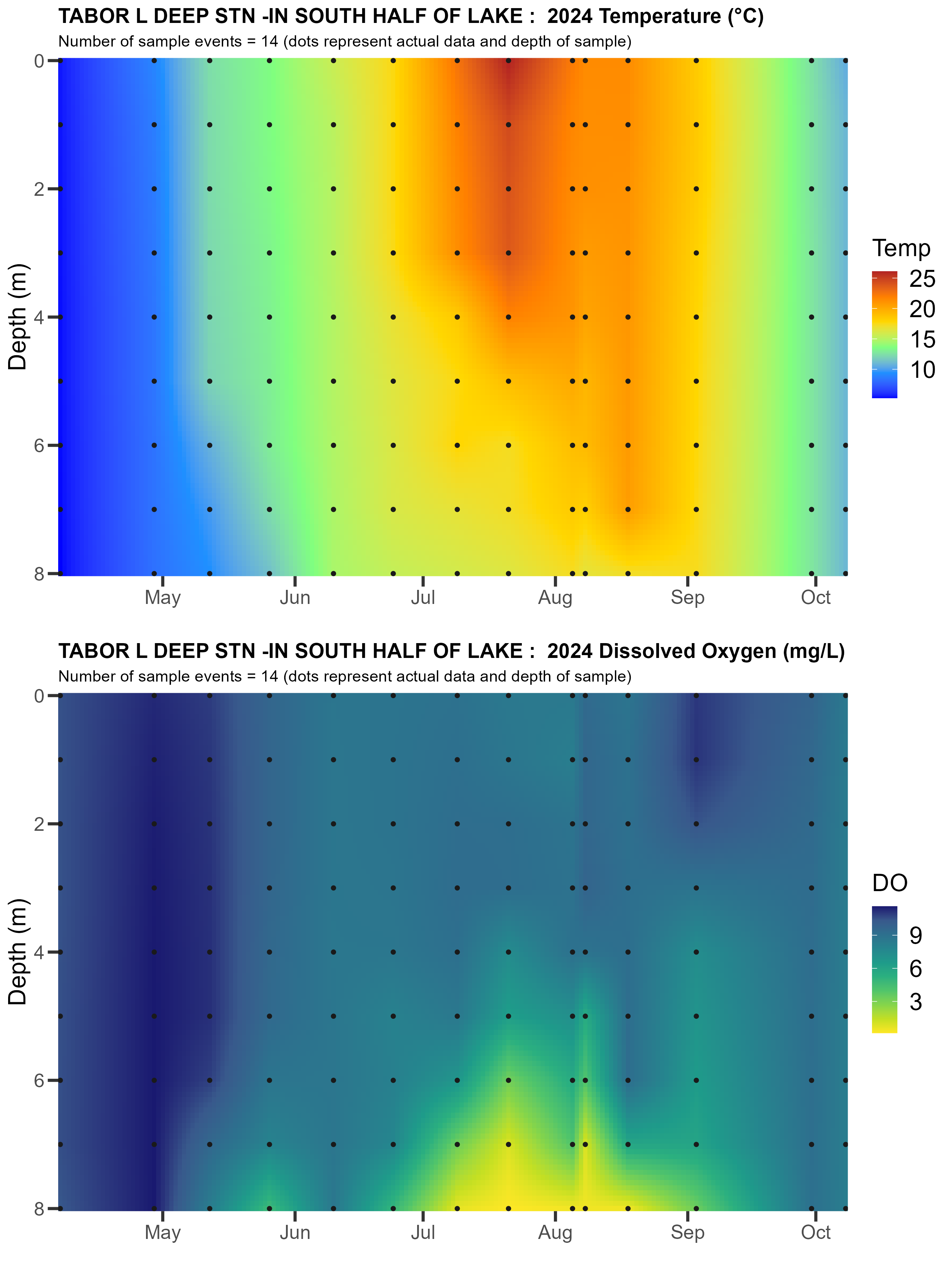
Water Clarity and Algal Productivity
Water clarity is measured using a Secchi disk. The Secchi depth can be used as an indicator of the presence of algal cells or other particulates, such as pollen, in the water column. For example, a deeper Secchi depth suggests clear water while a shallow Secchi depth suggests “cloudy” water which may be caused by the presence of algae. The following figure shows the Secchi depths collected by volunteer samplers at each sampling event.
The concentration of chlorophyll a in lakes is an indicator of algal productivity. Chlorophyll-a is a common pigment found in almost all plants and is used by plant life to capture the light energy that drives photosynthesis. In lakes chlorophyll-a occurs in photosynthetic organisms ranging from free-floating microscopic algae in the water column (phytoplankton) to rooted aquatic plants (macrophytes).
The following figure shows chlorophyll-a concentrations and the corresponding Secchi depths collected by volunteer samplers at each sampling event.
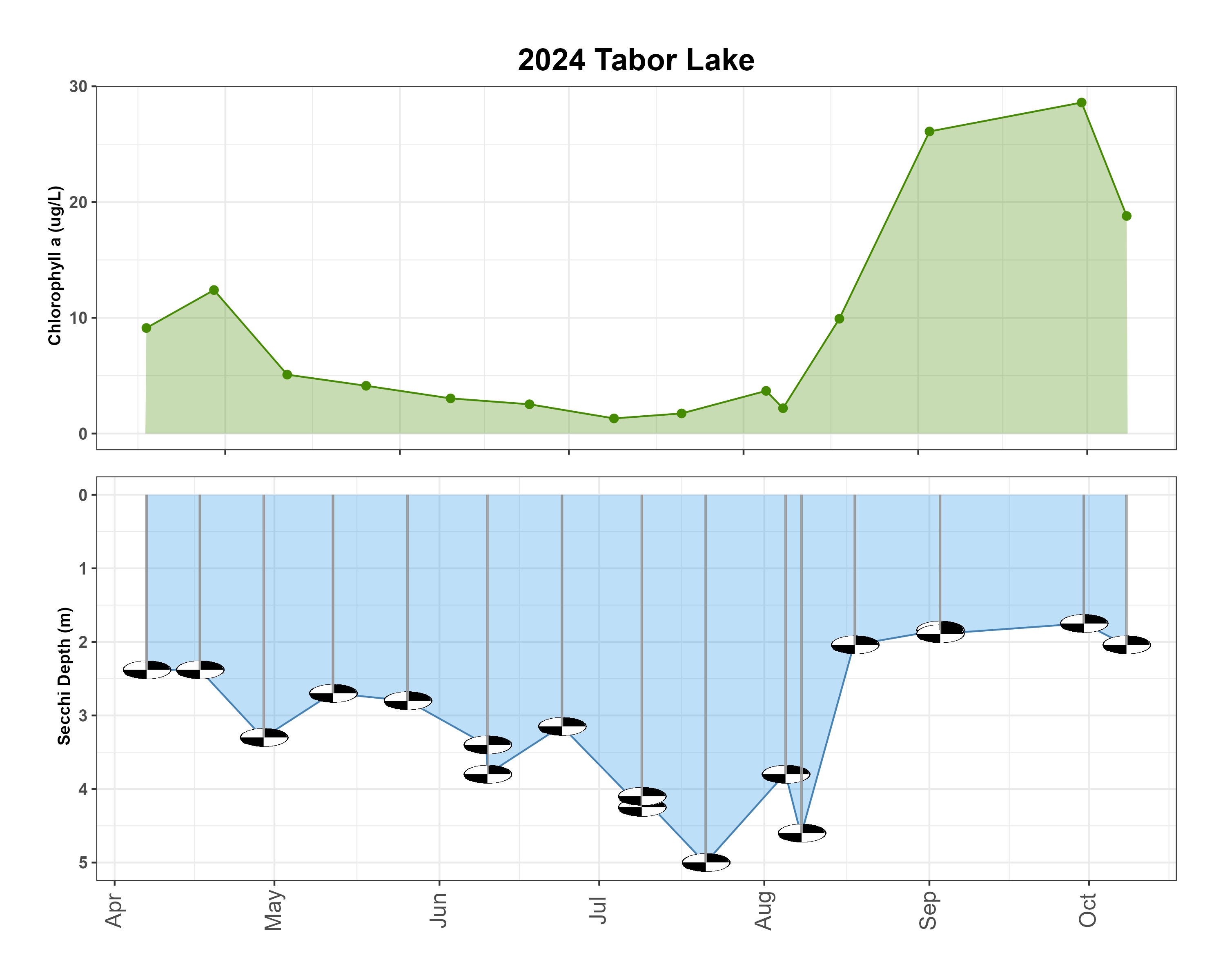
Nutrient Concentrations
Nitrogen and phosphorus are two of the most important nutrients to lake productivity. Most lakes in B.C. are phosphorus limited, meaning that phosphorus is the nutrient in shortest supply and thus acts to limit the production of aquatic plants and algae. When in excess, phosphorus accelerates growth and may artificially age a lake. Phosphorus exists in both total and dissolved forms. The dissolved form ortho-phosphate is the most bioavailable (easily used) by aquatic plants and algae for growth. Total phosphorus and total dissolved phosphorus are important for understanding how much potentially available phosphorus is in the lake. Examining all three forms provides more detail on the phosphorus loading dynamics of the lake. Level 3 monitoring programs sample water to analyze for total phosphorus, total dissolved phosphorus and ortho-phosphate. The graph below shows the concentrations of each of these during each volunteer sampling event.
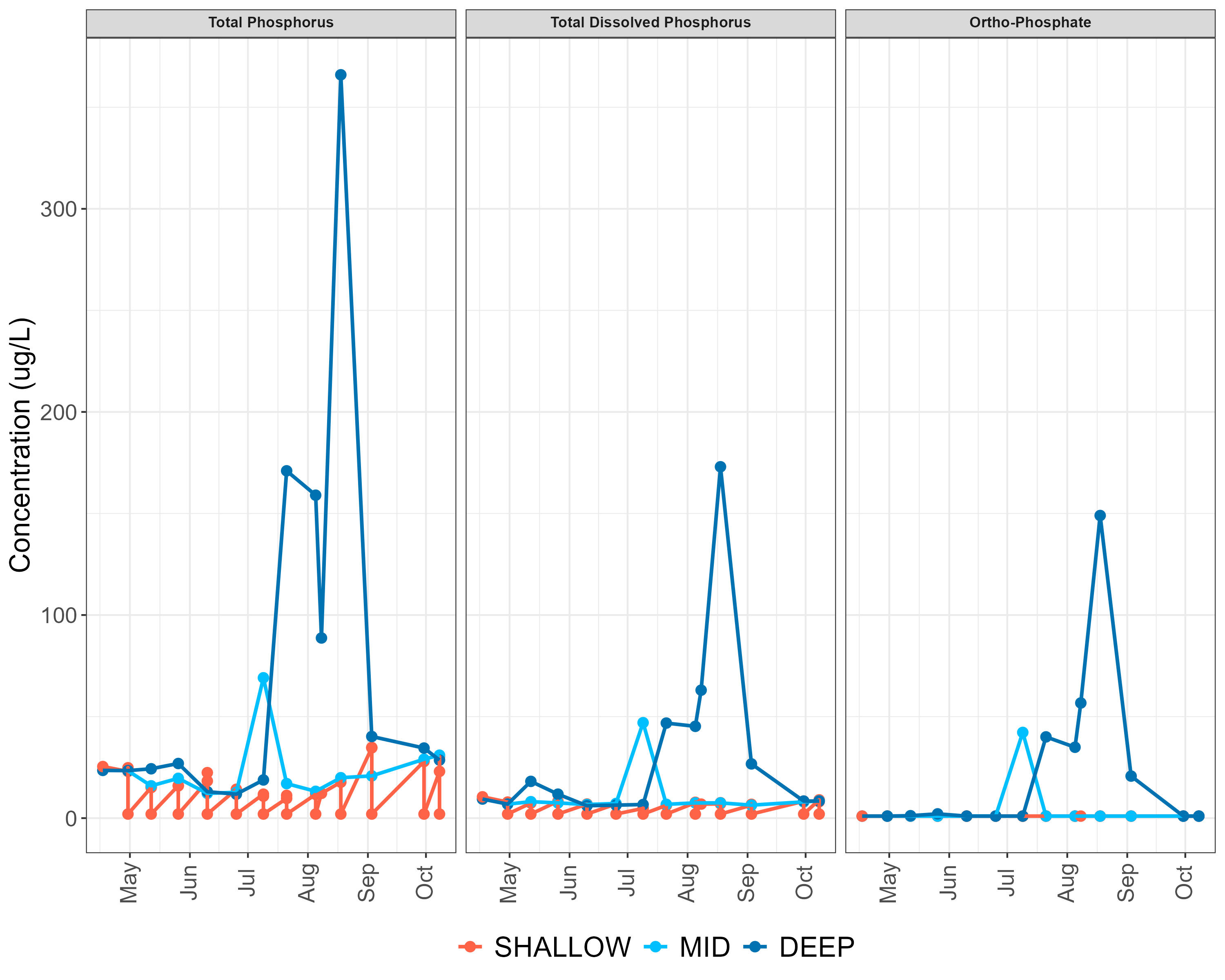
Lake Results Summary Table
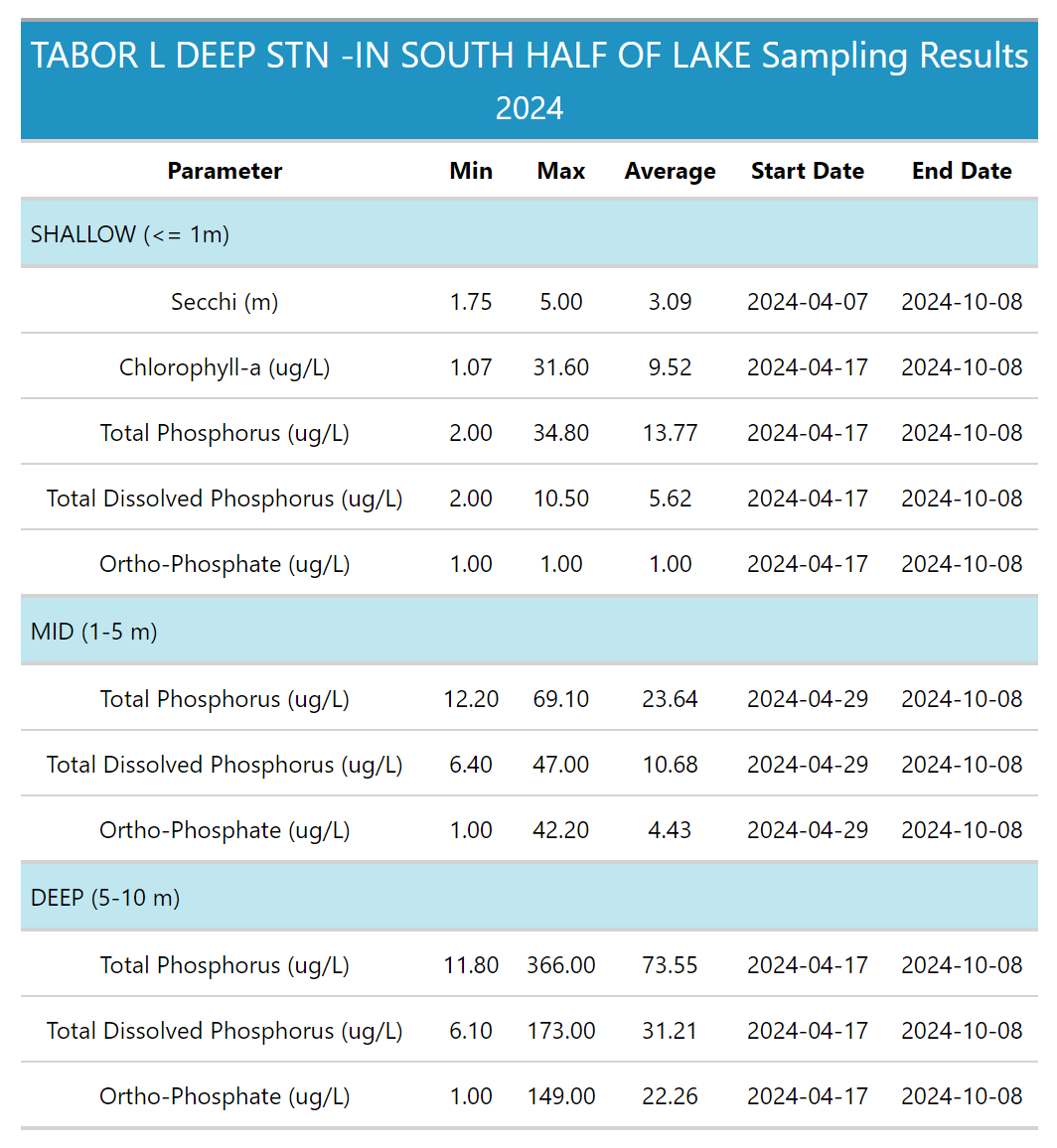
Disclaimer
This document provides a brief summary of annual sampling data but does not include an interpretation of results. Full reports, which include data interpretation, are published upon completion of each sampling program. For access to published reports visit the B.C. Lakes Stewardship Society (BCLSS) library here.
For further information, or to volunteer as a lake sampler, please mail volunterlakes@gov.bc.ca.
Web Browser Support
To view the interactive map, graphs, and reports, you must use an up-to-date version of one of these browsers: Chrome™, Firefox®, Microsoft Edge, or Safari. Reports and graphs may not display for Windows 7, Internet Explorer 11 users

